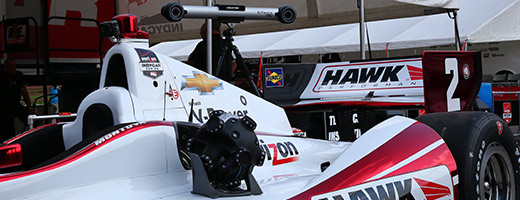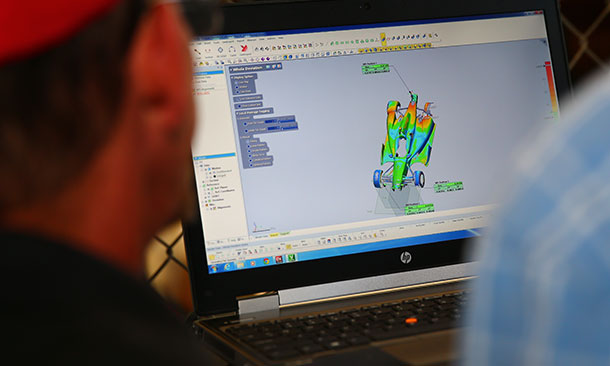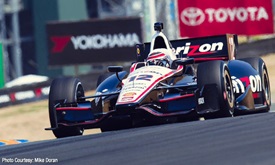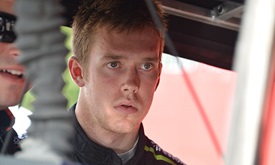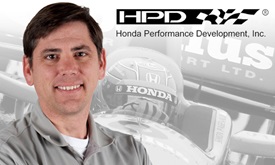Full body scans for '15: Policing of aero kits
AUG 08, 2014
Last of an overview of 2015 aero kits
Verizon IndyCar Series crew members form a half-circle as the colorful 3D image of their car that has just been laser scanned appears on the computer screen.
“That’s really cool and will save a lot of time next year,” one suggests.
INDYCAR director of aerodynamic development Tino Belli agrees on both counts and the latter is one of the reasons each car underwent a full body scan at Mid-Ohio Sports Car Course during the Honda Indy 200 at Mid-Ohio race weekend. Testing of a portable scanning system aligns with the detailed technical inspection process with the advent of aerodynamic body kits for the 2015 season supplied by Chevrolet and Honda.
Click it: HPD COO Steve Eriksen says variations between cars will be distinct
Separate aero kits are being designed by each manufacturer for road/street courses/short ovals and superspeedways. The manufacturer testing window for up to six on-track days opens Oct. 6 and closes Jan. 18, 2015. Verizon IndyCar Series teams will take delivery of the street/road course aero kits March 1, with on-track and wind tunnel testing opening March 13 depending on the 2015 racing schedule.
The full aero kits will debut at the Firestone Grand Prix of St. Petersburg on March 27-29.
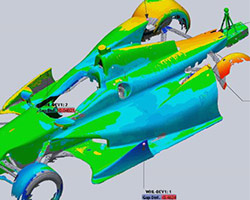 Laser scanning will complement the 100-plus areas measured and weighed during the technical and safety inspection process during race weekends. Homologated body components specified under the aero kit rules are off limits to alterations by Verizon IndyCar Series teams.
Laser scanning will complement the 100-plus areas measured and weighed during the technical and safety inspection process during race weekends. Homologated body components specified under the aero kit rules are off limits to alterations by Verizon IndyCar Series teams.
“The aero kits will be lots of different shapes and rather than make multiple templates to try to police the body shapes, with the scanner system we can get the whole car. We can check every single surface of the car rather than a few sections here and there,” Belli said. “It is easier for us to compare; we’ll have the exact differences between the homologated component and the actual car.”
Examples of areas open for development by INDYCAR-approved aero configuration manufacturers include sidepods, engine cover, rear wheel guards, front and rear wing endplates, speedway front wing main plane and the Indianapolis 500 rear wing mainplane.
“We have to protect the aero kit manufacturers to make sure what they have created is what we end up racing,” Belli added, “but the teams will have a lot more aerodynamic options then they currently have available to them, to try and get an edge over the other teams.”
The scanning exercise utilized laser scanners and three precision balls attached to the nose and attenuator that provide alignment for a complete deviation to a “gold standard” car that was theoretically perfect.
“A laser line is reflecting over the car and cameras built into the scanning unit are capturing the position,” said Jay Schaumberg, president of Online Resources that conducted the laser scanning. “By virtue of triangulation, the system knows exactly where each point that it captures is. Each scan is laying multiple millions of points over the surface of the car and the software is triangulating them into tiny triangles that represent the car. To our eye, it looks smooth in a 3D image.”
Different colors on the monitor represent tolerances accepted or outside the rules.
Laser scanning provides highly-accurate measurements regardless of the environment (vibrations and thermal variation) or operator skills. The new technology currently is being applied by the Boeing Company to inspect the assembled wings of its airplanes.
“The scan gives us a good representation of what the surface is doing over the entire area and can get an immediate deviation analysis of what it is currently to what it is based on the standard,” Schaumberg added. “Instead of having hundreds of templates, one scan will tell us everything we need to know.”
The aero kit program was announced in June 2013.
“Aero kits will improve the diversity of the fan experience and renew technical engagement, while providing a controlled cost structure,” said Derrick Walker, INDYCAR president of competition and operations.
